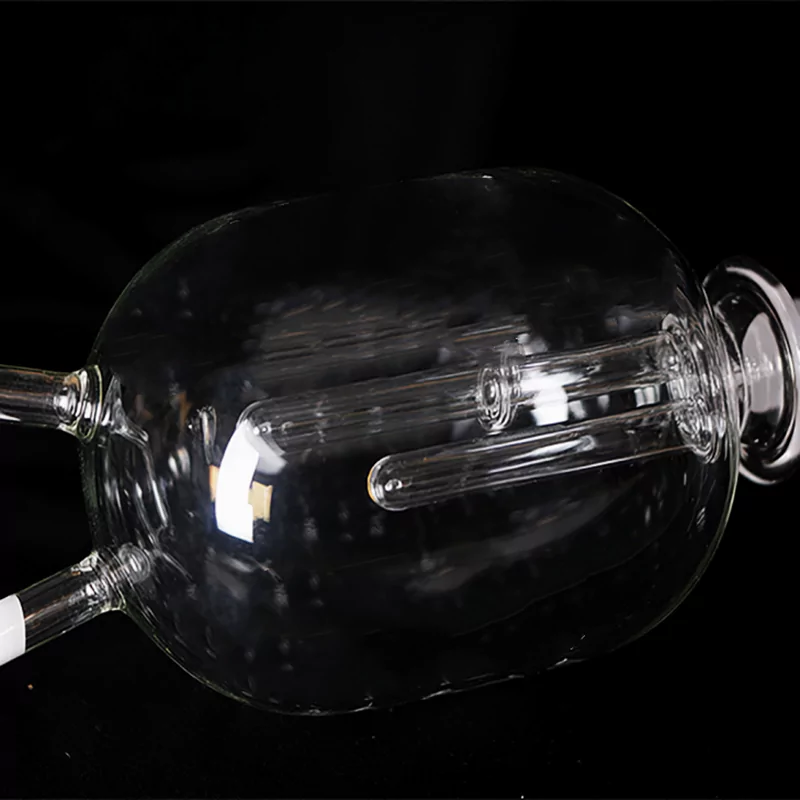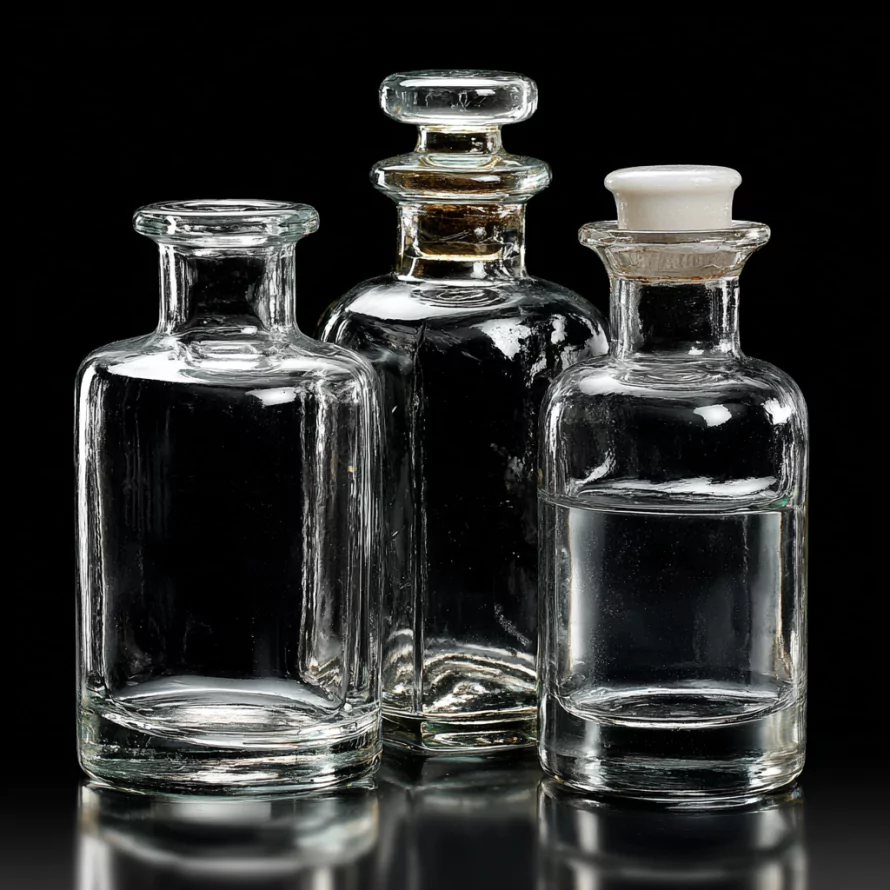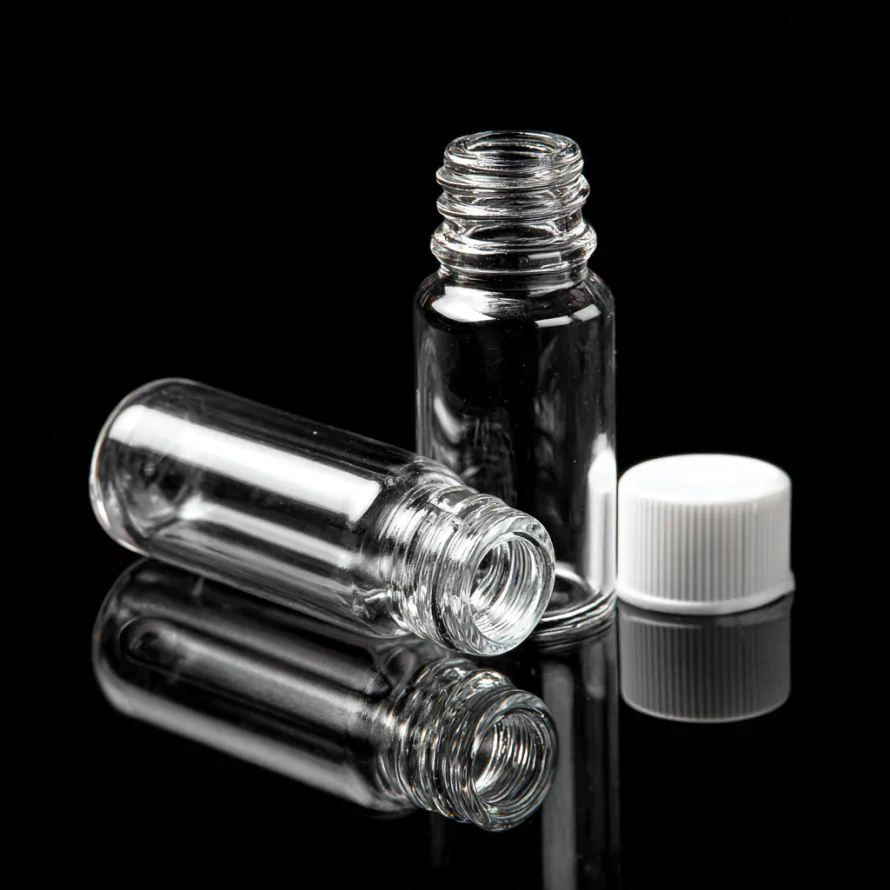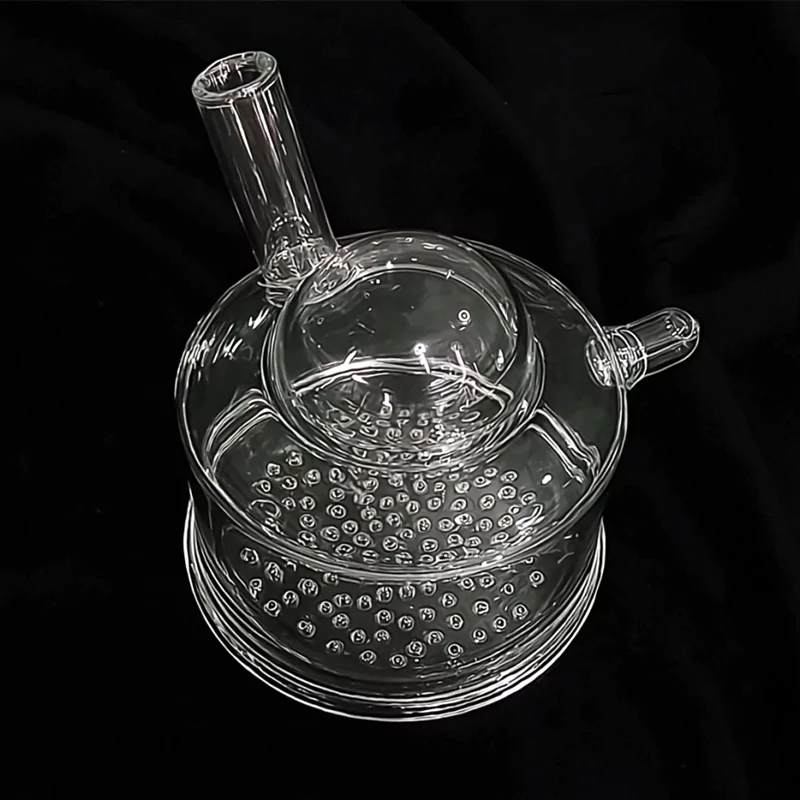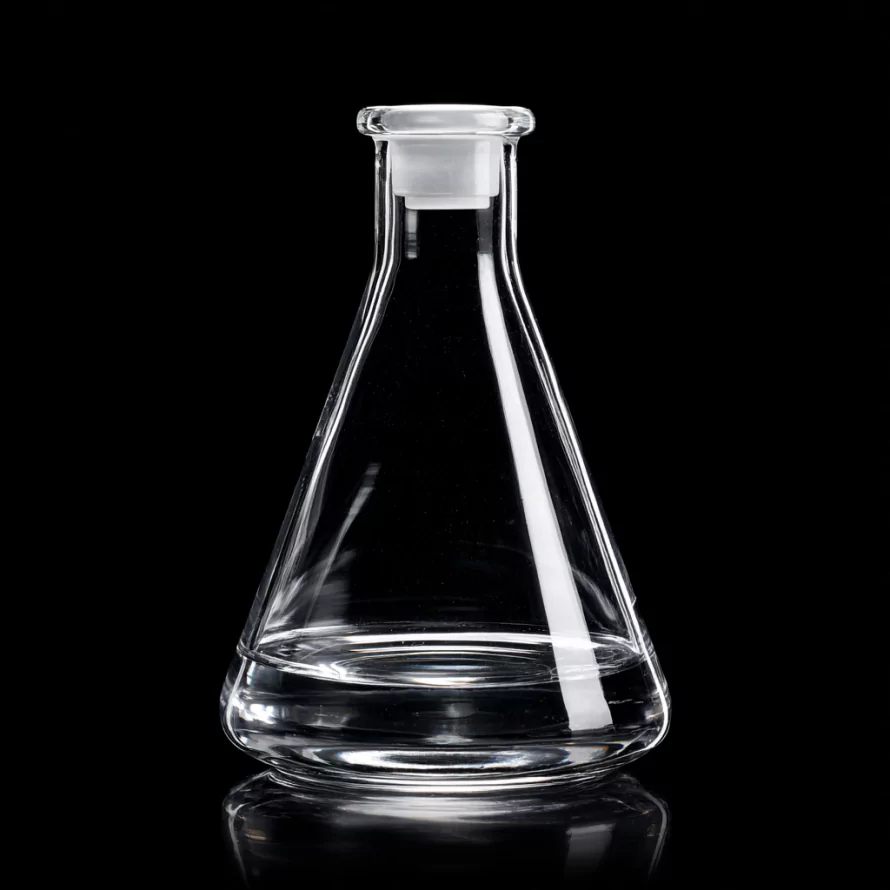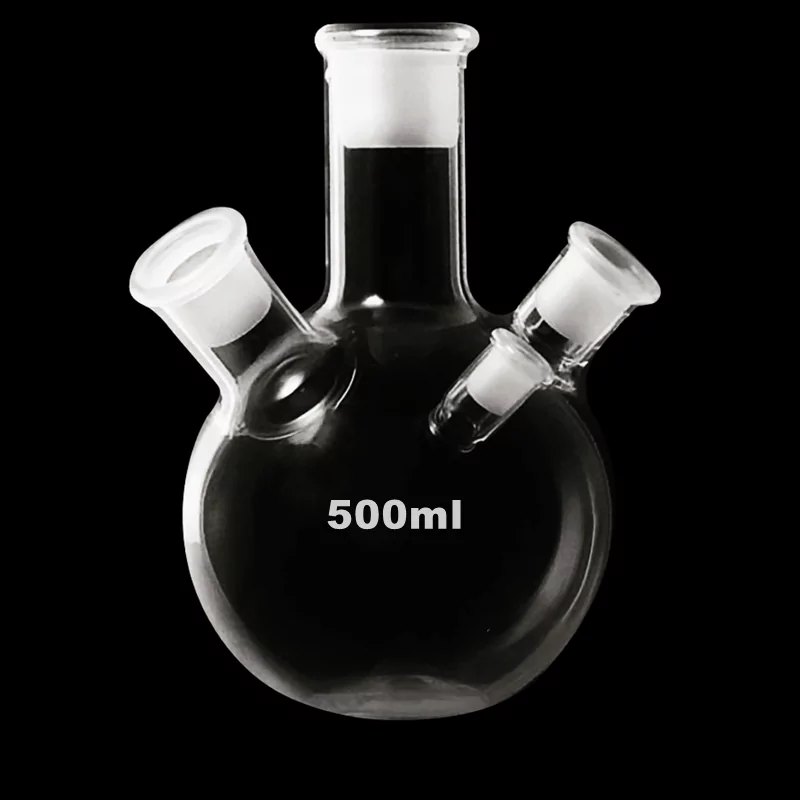- Home
- /
- Types
- /
- Quartz Bottle
- /
- Laboratory Quartz Glass Beaker...
Laboratory Quartz Glass Beaker for Thermal & Chemical Applications -TOQUARTZ®
Features of High Purity Quartz Beaker
High Material Purity
Manufactured from 99.99% SiO₂, our quartz beakers minimize contamination risks in sensitive experiments and provide reliable results in trace element analysis and semiconductor-related research.
Chemical Resistance
Highly resistant to acids, alkalis, and molten salts. Our quartz beakers remain stable when exposed to most chemicals, including hydrofluoric acid (in certain concentrations), making them ideal for corrosive material handling.
Thermal Stability
Withstands temperatures up to 1200°C with minimal thermal expansion (5.5×10⁻⁷/°C) and excellent resistance to thermal shock, allowing rapid temperature changes without cracking.
Optical Clarity
High transparency across UV, visible, and IR spectrums allows for clear observation of reactions and accurate volume readings. Transmission rates exceed 90% across 200-2000nm wavelength range.

- Material: 99.99% SiO
- Acid/Alkali Resistant
- Custom Sizes Available
Technical Specifications & Dimensions of Quartz Glass Beaker
Technical Specifications of Fused Silica Beaker
Physical Properties
| Property | Value | Unit / Notes |
| Density | 2.2 | g/cm³ |
| Maximum Working Temperature | 1200 | °C (continuous use) |
| Softening Point | 1730 | °C |
| Annealing Point | 1215 | °C |
| Thermal Expansion Coefficient | 5.5 × 10⁻⁷ | /°C (20–1000°C) |
| Thermal Conductivity | 1.4 | W/m·K (at 20°C) |
| Specific Heat Capacity | 670 | J/kg·K |
| Mohs Hardness | 5.5–6.5 | — |
| Compressive Strength | ≥1100 | MPa |
| Tensile Strength | 50 | MPa |
| Flexural Strength | 67 | MPa |
Chemical Properties
| Property | Value | Unit / Notes |
| SiO₂ Purity | ≥99.99 | % |
| Acid Resistance | Excellent | Except HF (hydrofluoric acid) |
| Alkali Resistance | Good | Stable in NaOH, KOH (low conc.) |
| Water Absorption | 0 | % |
| Solubility in Water | Insoluble | — |
| Leaching of Ions | Negligible | Suitable for trace analysis |
Optical Properties
| Property | Value | Unit / Notes |
| Refractive Index (nD at 589.3nm) | 1.4585 | — |
| UV Transmission (200–300nm) | ≥85% | For clear fused quartz |
| Visible Light Transmission | ≥93% | 400–700nm |
| IR Transmission (2.5–4.0μm) | Moderate | Decreases beyond 4μm |
| Birefringence | None | Isotropic material |
| Fluorescence | None | Under UV or visible light |
Dimensions of Fused Quartz Glass Beaker
| Model | Capacity (ml) | Outer Diameter (mm) | Height (mm) | SiO₂ Content (%) |
| AT-SY-B001 | 5 | 20 | 32 | 99.99 |
| AT-SY-B002 | 10 | 25 | 37 | 99.99 |
| AT-SY-B003 | 25 | 35 | 50 | 99.99 |
| AT-SY-B004 | 50 | 45 | 60 | 99.99 |
| AT-SY-B005 | 100 | 53 | 70 | 99.99 |
| AT-SY-B006 | 150 | 60 | 80 | 99.99 |
| AT-SY-B007 | 200 | 65 | 88 | 99.99 |
| AT-SY-B008 | 250 | 70 | 97 | 99.99 |
| AT-SY-B009 | 300 | 75 | 103 | 99.99 |
| AT-SY-B010 | 400 | 80 | 112 | 99.99 |
| AT-SY-B011 | 500 | 87 | 118 | 99.99 |
| AT-SY-B012 | 600 | 90 | 130 | 99.99 |
| AT-SY-B013 | 800 | 97 | 140 | 99.99 |
| AT-SY-B014 | 1000 | 105 | 158 | 99.99 |
| AT-SY-B015 | 2000 | 133 | 195 | 99.99 |
| AT-SY-B016 | 3000 | 150 | 225 | 99.99 |
| AT-SY-B017 | 5000 | 178 | 260 | 99.99 |
Solving Critical Challenges with TOQUARTZ® Quartz Glass Beakers
High-Temperature Chemical Reactions with Quartz Beakers
Key Advantages
-
Stable at 1200°C for 6+ hours
TOQUARTZ® beakers maintain structural integrity during continuous exposure to 1200°C for over 6 hours without deformation or microcracking. -
Ion leaching < 0.01 ppm at 1000°C
ICP-MS tests confirm ion release remains below 0.01 ppm even under prolonged acid heating at 1000°C, ensuring sample purity. -
No devitrification after 50 thermal cycles
After 50 cycles between 25°C and 1100°C, TOQUARTZ® beakers show no surface devitrification or structural fatigue.
TOQUARTZ® solution
A materials science lab in Stuttgart, Germany, previously used aluminosilicate vessels for acid digestion at 950°C, which showed visible surface degradation after 10 cycles.
After switching to TOQUARTZ® quartz beakers, they completed 60+ thermal cycles with zero structural change and reduced sample contamination by 92%, verified via post-reaction ICP-OES analysis.
Precision Optical Material Development with Quartz Glass Beakers
Key Advantages
-
Dimensional tolerance within ±0.15 mm
TOQUARTZ® beakers are manufactured with verified dimensional accuracy of ±0.15 mm, suitable for sealed optical reaction chambers. -
Surface roughness Ra < 0.02 μm
Polished inner walls ensure minimal particle adhesion and optical interference, confirmed via profilometer measurements. -
Trace metal content < 0.5 ppm total
Material analysis shows total trace metal impurities below 0.5 ppm, minimizing contamination in photonic material synthesis.
TOQUARTZ® solution
A Japanese photonics R&D firm required quartz vessels with <±0.2 mm tolerance for UV-curable polymer synthesis. Previous suppliers delivered inconsistent batches, causing 14% yield loss.
TOQUARTZ® provided beakers with certified ±0.15 mm tolerance, reducing batch rejection to <2% and improving optical clarity by 18% (measured via UV-Vis spectrometry).
Educational Laboratory Applications with Fused Silica Beakers
Key Advantages
-
Breakage rate < 1% over 12 months
In student labs, TOQUARTZ® beakers showed <1% breakage rate across 300+ uses, even under rapid heating conditions. -
Maintains volume accuracy after 100 uses
Graduation markings remain legible and accurate within ±5% after 100 heating/cooling cycles in teaching environments. -
Resistant to 10% HCl and 5% NaOH at 90°C
Chemical durability tested under repeated exposure to common teaching reagents at elevated temperatures.
TOQUARTZ® solution
A Canadian university chemistry department replaced 80 borosilicate beakers annually due to thermal shock and acid etching.
After adopting TOQUARTZ® quartz beakers, annual replacements dropped to 6 units, saving over CAD 2,400 and improving lab continuity across 3 academic terms.
TOQUARTZ® Custom Quartz Beaker Design & Manufacturing Services
Technical Design Support
TOQUARTZ® engineering team provides technical drawing assistance and design optimization for specialized quartz beakers. We can work from concept sketches, detailed CAD files, or modify existing designs to meet your specific requirements.
- Technical drawing development
- Material selection guidance
- Tolerance optimization
Custom Manufacturing Capabilities
Our specialized manufacturing facilities can produce quartz beakers with non-standard dimensions, modified spouts, custom wall thicknesses, and special markings. We excel at small-batch production of highly specialized laboratory equipment.
- Non-standard capacities
- Special wall thickness configurations
- Modified spout designs
Special Application Development
For research teams with unique requirements, we offer collaborative development of application-specific quartz beakers. This includes modifications for controlled atmosphere systems, specialized heating applications, or integration with existing equipment.
- Custom fittings and connections
- Multi-chamber beaker designs
- Integrated temperature monitoring

Customization Process
Technical Consultation
- Discuss your quartz glass beaker application, including temperature range, chemical exposure, and dimensional constraints with our engineers.
Design Proposal
- We provide detailed drawings and 3D models of the custom quartz beaker, including wall thickness, spout design, and volume markings.
Prototype Development
- A sample quartz beaker is produced for dimensional and functional validation, ensuring it meets your lab or equipment integration needs.
Production & Quality Control
- Once approved, we begin batch production with strict QC on SiO₂ purity, dimensional tolerance, and surface finish.
Usage Guidelines of Quartz Glass Beaker
To maximize the performance and lifespan of your TOQUARTZ® quartz beakers, follow these recommended handling, usage, and storage guidelines. Proper care ensures continued accuracy, optical clarity, and thermal resistance.
Handling Recommendations
- Always handle with clean gloves or tongs to prevent contamination and fingerprints that can etch into the surface during high-temperature applications.
- Avoid mechanical shock; while quartz is more durable than standard glass, impact can still cause micro-fractures that may develop into breaks during thermal cycling.
- When transporting heated beakers, use appropriate heat-resistant holders designed for laboratory glassware.
- Do not place hot quartz beakers directly on cold surfaces; use a heat-resistant mat or ceramic plate to prevent thermal shock.
Temperature Management
- For optimal performance, temperature increase should not exceed 300°C per minute, especially when beakers contain liquids or solids.
- When cooling from high temperatures (>800°C), allow gradual cooling at approximately 200°C per minute to prevent thermal stress.
- Maximum recommended continuous operating temperature is 1100°C, with short exposures possible up to 1200°C.
- For applications involving liquid nitrogen or other cryogenic materials, pre-cool beakers gradually to minimize thermal shock.
Cleaning Protocol
- For routine cleaning, rinse with deionized water followed by a final rinse with laboratory-grade ethanol or acetone.
- For removing stubborn residues, soak in a 10% nitric acid solution, followed by thorough rinsing with deionized water.
- Avoid abrasive cleaning materials that can scratch the surface and create nucleation points for cracks.
- For sterilization, autoclave at standard conditions (121°C, 15 psi) or heat to 500°C for 30 minutes in a clean furnace.
Storage Guidelines
- Store in dust-free cabinets, preferably wrapped in lint-free paper or stored in dedicated containers to prevent dust accumulation and surface contamination.
- Keep away from areas with mechanical vibration that could cause movement and potential damage through contact with other items.
- For long-term storage, ensure beakers are completely dry to prevent mineral deposits from forming on the surface.
- Periodically inspect stored beakers for signs of damage before returning to service.
Need Technical Assistance with Quartz Beakers?
Get expert guidance for your research or industrial application.
Why Partner with TOQUARTZ
Direct Factory Advantage
As a direct manufacturer, we can cut out the numerous intermediate links.
Engineering Expertise
Technical team guides clients from material selection to design optimization, translating specs into deliverables.
Flexible Manufacturing
Handling standard & custom orders via small-batch expertise and prototyping rigor to meet urgent deadlines.
Quality
Assurance
Pre-shipment 3-step validation:
1. dimensional accuracy,
2. material purity ,
3. performance thresholds
Global Supply Chain
Reliable global logistics to industrial hubs (DE/US/JP/KR priority) with trackable milestones.
Releted Products
As a specialized manufacturer with direct factory capabilities, TOQUARTZ provides both standard and custom quartz solutions with engineering support throughout the specification and implementation process.
FAQ
Q: Are TOQUARTZ quartz beakers resistant to hydrofluoric acid (HF)?
A: While our quartz beakers show excellent resistance to most chemicals, hydrofluoric acid (HF) is an exception. HF reacts with silica (SiO₂) to form silicon tetrafluoride and water. The rate of reaction depends on HF concentration, temperature, and exposure time. For very dilute HF solutions (< 1%) at room temperature, limited short-term exposure may be possible, but we do not recommend using quartz beakers for HF-containing solutions. For applications involving HF, we recommend using specialized containers made of fluoropolymers like PTFE or PFA.
Q: Can quartz beakers be used directly on open flames or hotplates?
A: Yes, quartz beakers can be used directly on laboratory hotplates, over Bunsen burners, or in direct flame applications. However, we recommend the following precautions: (1) Use a wire gauze or ceramic-centered wire gauze between the flame and beaker to distribute heat more evenly; (2) When heating on hotplates, ensure the beaker bottom is clean and the hotplate surface is flat; (3) Avoid sudden temperature changes when the beaker contains liquids; (4) For direct flame applications, introduce the beaker gradually to the heat source. While quartz has excellent thermal shock resistance, following these guidelines will maximize the service life of your beakers.
Q: How accurate are the volume markings on TOQUARTZ quartz beakers?
A: The volume markings on our standard quartz beakers are provided as approximate guides rather than for precise volumetric measurement. For standard beakers, volume accuracy is typically within ±5% of the indicated volume. If precise volumetric measurement is critical for your application, we recommend using calibrated volumetric glassware in conjunction with our quartz beakers, or requesting specially calibrated quartz beakers, which we can produce with volume accuracy within ±2% for specific applications. Each calibrated beaker undergoes individual verification and is supplied with a calibration certificate.
Q: How do quartz beakers differ from standard laboratory glass beakers?
A: Quartz beakers differ from standard borosilicate glass beakers in several important ways: (1) Temperature resistance: Quartz can withstand up to 1200°C versus 500-600°C for borosilicate; (2) Chemical purity: Our quartz is 99.99% SiO₂, whereas borosilicate contains various other oxides; (3) Thermal expansion: Quartz has approximately 1/3 the thermal expansion coefficient of borosilicate, making it much more resistant to thermal shock; (4) UV and IR transmission: Quartz allows transmission of UV and IR wavelengths that would be blocked by standard glass; (5) Chemical resistance: Quartz offers superior resistance to most acids (except HF) and bases.
Q: Can TOQUARTZ provide quartz beakers that match the specifications of other manufacturers?
A: Yes, we can produce quartz beakers that match or exceed the specifications of other manufacturers. If you’re looking to replace or supplement existing laboratory equipment, we can work from dimensional samples, competitor part numbers, or technical specifications to create compatible replacements. This capability is particularly valuable for laboratories facing supply chain challenges with their current vendors or seeking cost-effective alternatives without modifying existing procedures or equipment setups. Please provide as much detail as possible about the items you wish to match, including dimensions, markings, and any special features.
Contact our engineering team for technical consultation and pricing. We’ll help you select the optimal specifications for your application requirements.






